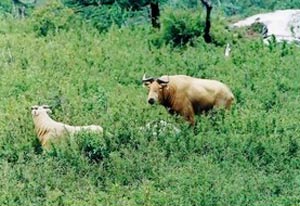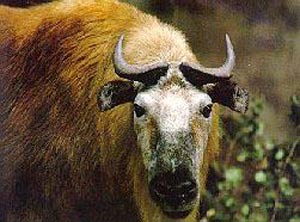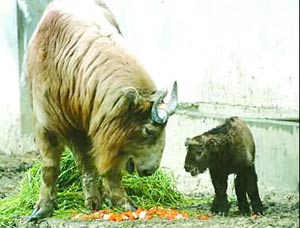Source: CCTV.com
05-24-2006 10:34

The rugged Qinling Mountains are the dividing line between North and South China. It's also home to several rare wild animal species including the Takin, which attacked Zou Jianhua. It's also known as the "golden-fleece" takin. Takins live high in the mountain above 2000 meters. They are herbivores that live in herds. An adult takin weighs about 300kg, and is about two meters long. The male takin has shaggy golden hair all over its body.
The female takin has a beautiful white coat. It looks like it's a mix of an ox, goat, horse and pig. The locals call takins the "six-unlikely" or the "white goat".
As a result of evolution, their forelegs are stronger and stockier than their hind legs to live in a rocky mountainous environment. They can even leap nimbly on 70-degree slopes.
Song Yanling, Science Academy of China Animal Research Institute said: "Takins are distinctive to China, with few found elsewhere in the world. It's similar to the ox and the goat. It's appreciated for its beauty and strength. Takins have always attracted explorers and biologists. Since the 1960s, China has listed takins on the national first-class animal protection list."
Within the nature conservation, there have been few cases of attacks on humans. Was this just a coincidence?
The takins' attacks caught the attention from the Wild Animal Protection Department,Forestry Office in Shanxi Province. They carried out a special investigation; their findings were surprising.
According to statistics, there are more than 5500 takins in the Qinling mountains region. They usually stay in their habitat. Why did they move down the mountain and attack people?
Jiuchi Village, where Zou Jianhua lives, is at an altitude of 1300-meters. As the climate in the mountain is adverse and the cultivatable land is limited, their crop yield isn't high.
Zhang Shiqing: "We couldn't plant the wheat or cole crops as we did before. As they grew, the takins would come down and eat them. We didn't get near them. We avoided them and ran back home."
To prevent more losses, the villagers requested help from the county Forestry Office. After they received the report, the staff of the Wild Animal Conservation Station rushed to the site before sunrise.
The villagers led the investigators to the hill where the takins often emerged. They hoped they could find the takins and learn about their habits.

Takins usually form a herd to prevent attacks from their predators. Their color allows them to blend in with the rocks.
At the beginning of the spring, the top of the mountain was still covered with ice and snow. The takins were short of food. Yet, there were abundant food sources in the low-altitude region of the mountain, so they migrated down in herds.
The locals call their behavior "rushing the harvest of greens". It's a vivid description. At that time, the takins would go down from the high mountain together. As the temperature gradually gets higher, they would move back up the mountain. The process of the migration is a quick one. It took them about one month to move from the low-altitude region up to their high-elevation habitat, about 2000 meters in the summer.
Every herd is made up of a few male takins, several females, and young kids. During mating season, the male takin chases the female. Within a takin herd, only the strongest males have the right to mate. To fight for their mating rights, the male takins provoke the head takin.
These dueling takins would be driven out of the herd by the head takin. This is good. Why?
Relatively saying, the single takins are inferior. Yet, they don't know their place. They would keep fighting in other herds.

It seemed that the defeated male takin made its way down the mountain easily. It was hard to discover the true reason behind its attacks. The Provincial Forestry Bureau decided to let them capture the takin. They would have to use a tranquilizer gun.
The range of the gun is quite short. The staff has to get closer to the takin. Once the tranquilizer needle enters the takin's body, it will take effect within 10 minutes. This is dangerous for the staff.
Wild animals have quite strong sense of territory. When other animals approach the takins, they will become defensive. They will use their noses to breathe, judging if the approaching person or animal is really a threat. If you get too close, it will give you a warning roar.
Some takin specialists have investigated the takins' living habits in the mountain and had come into close contact with them without being attacked.
Within a herd, the takins have more tolerance when they see humans. We had been very close to them, like five meters, 10 meters. A single takin is more defensive and wary of humans.
To their surprise, they learned it was an old weak takin. It took all the staff's effort and strength to carry it down the mountain. It's hard to understand why this takin attacked the villagers.
It attacked them because it felt threatened, because it was alone. The place where it was living
wasn't its home. Its true habitat is at elevations above 1500-meters. They're most often found above 1800 meters. This lower-altitude area isn't its habitat. It's not familiar with this area. Once it saw a man, it would have considered him a threat. It attacked the man out of self-protection.
This old takin was left behind by its pack because it couldn't climb as fast as the others. It was too weak to climb up the high mountain. It couldn't chew off the hard tree branches for its teeth were grinded flat. The crop and the vegetables in the field are fresh and delicious; and the brook provided water, so it decided to stay. Filled with fear and separated from its herd, it was more sensitive and vulnerable.
Editor:Ge Ting
